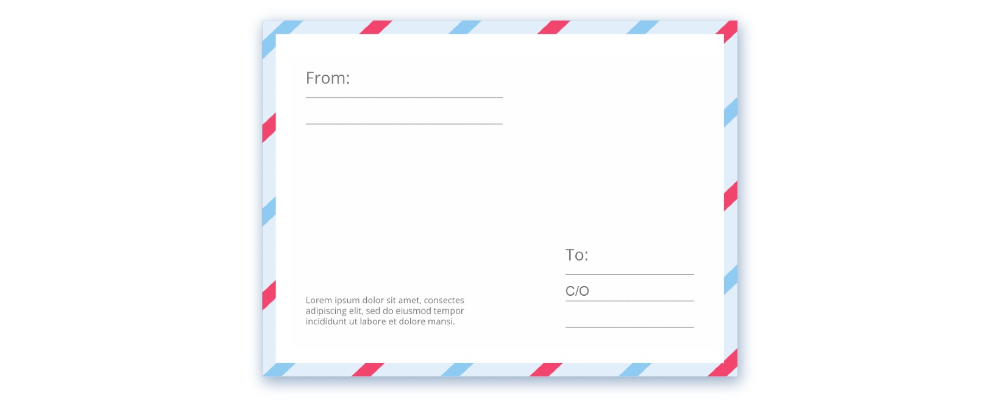How to Write International Address the Right Way to Ensure Accurate Deliveries
Australia Post delivers 2.7 billion items a year! This figure includes all individual and commercial postcards, letters, and parcels that the Post Office shipped.
Thousands of customers send mail to international locations via Australia Post every year. But worldwide mailing needs them to learn how to write international addresses correctly.
You cannot use the same Australian mailing address format you use to send mail within the country.

Instead, you should use a format that matches the guidelines of the destination country’s postal organisation.
Understanding how to address international mail also helps you ensure that your mail reaches the right destination. It speeds up the mailing process and allows the postal workers to send your items on time.
Keep reading this guide to learn how to address an international letter correctly. Also, we will discuss the different ways to send international mail through Australia Post.
Let’s get started!
Prime Guidelines to Know While Addressing International Mail
Australia Post has a set of guidelines for international addressing to help you send mail to global destinations effortlessly, including:
- Write all your mailing addresses in capital letters. It is advisable to also write the recipient’s name with the delivery address in all caps.
- Make sure that your addresses do not exceed five lines.
- If they exceed this limit, try clubbing two or more lines to shorten them.
- While learning how to write an international address on an envelope or package, cross-check the location with the receiver.
- All delivery addresses must be typewritten or printed using blue or black ink. Avoid using light colours on dark-coloured paper stock.
- Prevent the use of pencils and pens for addressing international mail. Remember that handwritten addresses are prone to scrubbing, erasing, and other issues, making it hard to complete deliveries.
- Always write the recipient’s full legal name on the first line. A legal name is a name appearing on the person’s government ID. It includes their first and middle name or initial (if any) and last name. Here’s an example- Mona S Collins.
- When you learn to write address international, the first thing to know is that your addresses must appear legibly. Any scratches, spelling mistakes, ink blotting, etc., can lead to delivery failures.
- Use Arabic numerals and Roman letters for addressing international mail. Plus, take care that they are placed lengthwise towards one side of your envelopes or packages.
- After knowing how to write your address for international mail and using the correct format, you must fill out a separate slip enclosed with packages.
- Mailing addresses with Greek, Hebrew, Arabic, Russian, Japanese, Chinese, or Cyrillic characters must have an interline English translation. If you don’t know this version, write the foreign language using Roman characters.
- When you understand how to write an address for international mail, you will notice that all international addresses have the country name on the last line. It tells the postal workers where to redirect their mail without checking the postal codes. Ensure to write your destination country’s name in uppercase letters (avoid using abbreviations).
- Place the foreign postal codes above the country name while addressing international mail items. Check whether your destination country’s guidelines need you to place the postal code before the city or town.
The above guidelines help you learn how to write an international address in a letter. You can also access the Universal Postal Union website to check if your destination country has additional formatting requirements. However, this step only works well if your destination country is a United Nations member.
How to Address International Mail
Different standardisation rules, alignments, and address formats exist for every destination country. However, you can use one standard, customisable format for international addressing, as written below:
Line 1: Recipient’s full name
Line 2: House number and street address/ PO box address
Line 3: City name followed by province, state, or county name and postal code
Line 4: Country
But it is not enough to only refer to this format for addressing international mail and packages. Please remember that these aspects could differ considerably from country to country.
Hence, let us learn about the above elements in detail to learn further how to write your address for international mail:
- House number: It could also be a floor or suite number.
- Street address: Your recipient’s address may or may not have a street address. Sometimes, it may have a PO box number that replaces the house number and street address.
- City name: When exploring different ways to write an international address on an envelope, you may come across towns and municipalities. Not surprisingly, some countries use these terms instead of ‘cities.’
- Postal code: Postal codes also go by various names in different countries, like ZIP codes in the US, postcodes in the UK, etc.
Find below some examples of how to write international addresses on packages and letters:
CHANDLER J GILBERT
2089 BAKER ST
LONDON W1U 6RN
ENGLAND
CLAIRE TONKIN
PO BOX 752
NEW YORK CITY NY 10011
USA
ANDREW ADAMS
1212 PARKDALE AVE
OTTAWA ON K1Y 1J2
CANADA
It may be complicated to know how to write a postcard address international, but it can help you save loads of effort and time. Some other tips that might help you are:
- The delivery address must always appear in the middle of your envelope or label.
- Affix one or more postal stamps enough to cover your delivery costs in the top right-hand corner.
- Place the return address towards the top left-hand corner on the same line as your stamps.
While addressing international mail, write the addresses and affix the stamps on the front side of your package or envelope.
How to Write a Return Address on an International Letter
Australia Post recommends writing a return address on all international mail items for security. Also, it can help you get your mail back if it does not reach your recipients for specific reasons.
Some people know how to write an international address but forget to mention their return address. Thus, postal employees have difficulty tracking the sender and returning undelivered mail. As a result, they discard such items, and the sender isn’t even informed.
Hence, you should also know how to write an international address for Australia.
Below is an example of the Australia address format that you can use for your return address:
KATHERINE GRANGER
17 AIRPORT FWY
SYDNEY NSW 2108
There is no need to mention the country name in your return address. Some other Australia Post guidelines to keep in mind for knowing how to write an Australian address for international mail are:
- Use abbreviations for writing state or county names.
- Leave two spaces between the abbreviation and the postcode.
- Avoid using initials instead of the recipient’s name unless it is an adopted business name.
- Write the city, state, and postcode the same way as you do when addressing international mail.
- Refrain from using punctuation marks.
Which Type of Stamps Do You Need to Send International Mail?
After knowing how to write an address for international mail, it is time to affix your stamps.
You require Australia Post’s international postage stamps to send international letters and parcels.
The number of stamps you need depends on the postage rate of your item. And the cost of one stamp costs starts at $0.05.
So you need to stick an adequate number of stamps to cover your postal fee. Luckily, these stamps never expire, and you also don’t need to pay any surcharges in case of inflation.
If you are still struggling to understand international mail- how to write addresses, and calculate postage, try PostGrid’s direct mail services. They can help you create your items, print, address, and mail them in an automated way.
Also Read: What Is Transliteration And Why You Need It For Effective Business Communication?
Why Do You Need to Know How to Address an International Letter?
Now that you know how to write an address internationally, you should also understand why it is a crucial step.
Firstly, Australia Post cannot determine whether your international delivery address is valid and correct.
Thus, it is hard to tell if your item will be delivered to the correct address or returned to you.
Also, it may not help you access the foreign postal codes you need for addressing international mail. So, you may find it impossible to know how to write address for international packages without contacting all your recipients personally.
You can use PostGrid’s address verification API or software in such cases. They can effortlessly help you with international address transliteration, standardisation, and validation.
Some of the other features of our address verification services include:
- On-demand and bulk validation: You can validate any number of mailing addresses in one go with just a few clicks. PostGrid’s API is scalable and can accommodate your growing needs.
- Address autocomplete: Don’t know how to write an international address? No problem! PostGrid’s address validation API can help you auto-complete addresses within a few keystrokes. This way, you can access high-quality, deliverable mailing addresses in seconds.
- AMAS-certified: PostGrid uses Australia Post’s Address Matching Approval System (AMAS) addresses for verification. This certification helps PostGrid access authoritative databases and lets you know how to write international addresses.
- Zero-code integration: With our zero-code integration feature, you can integrate our API into your CRM without technical expertise. The process is simple and speedy, allowing you to start instantly.
PostGrid’s address verification solutions can help you skip the part where you need to know how to write an address on international mail.
We understand it can be daunting and complicated to remember the postal address formats of several countries and abide by the guidelines. Thus, all you need to do is integrate our API into your system and start standardising and validating your addresses.
Wrapping Up
Sending international mail requires you to understand how to address an international letter. You must follow the guidelines of the respective postal organisation of the destination country. Most of the time, the format is almost the same, but there are some minor details that you need to take into consideration.
If you want to save time, cost, and effort, try Postgrid!
Request a demo now to see how we can help you with addressing international mail!
Ready to Get Started?
Start transforming and automating your offline communications with PostGrid
The post How to Write an International Address appeared first on PostGrid.
Via https://www.postgrid.com.au/how-to-write-an-international-address/
source https://postgridaustralia.weebly.com/blog/how-to-write-an-international-address




